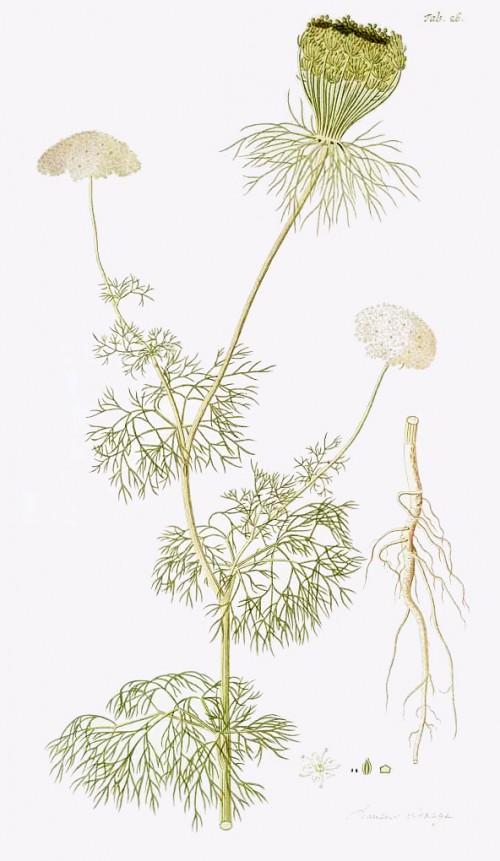Dies ist eine alte Version des Dokuments!
Ammi visnaga (L.) Lam. - syn. Daucus visnaga L.; Visnaga daucoides Gaertn. - Apiaceae
khella, toothpickweed, bishop's weed, Zahnstocher-Ammei, Zahnstocherkraut, Bischofskraut
Taprooted erect annual herb, 0.50-1.20 m high, native to the Mediterranean, Southwest Asia, North Africa, naturalized in North America, cultivated elsewhere; lower leaves long-petioled, pinnate; higher leaves bi- or tripinnate, aristate; flowers white or yellow-white on long-stalked umbels; seeds small (2mm long), oblong-ovoid, very bitter tasting.
„Used in oriental countries for the production of toothpicks, with their spicy taste is welcome.“ http://de.wikipedia.org/wiki/Bischofskraut
The fruits of A.visnaga are rich sources of the furanochromones khellin and visnagin, which are smooth muscle relaxants and vasodilators.
[High performance liquid chromatography analysis of the furanochromones khellin and visnagin in various organs of Ammi visnaga (L.) Lam. at different developmental stages. Franchi, G. G., et al., Journal of ethnopharmacology, Vol.14 (2), 1985, 203-212]
Preparations of the seeds have been used to treat diseases of the heart like angina pectoris, coronary insufficiency, tachycardia, extrasystoles; and of the respiratory tract, such as asthma and whooping cough.
Side effects include dizziness, reversible cholestatic jaundice, pseudoallergic reaction, and elevated levels of liver enzymes (transaminases and gamma-glutamyltransferase). Ammi visnaga is one of the species having been evaluated negatively due to missing data on efficacy.
[Blumenthal, M. (1998). Therapeutic guide to herbal medicines.] see also http://buecher.heilpflanzen-welt.de/BGA-Kommission-E-Monographien/ammeos-visnagae-fructus-ammi-visnaga-fruechte.htm
The dried ripe fruits (Ammi visnagae fructus) are used as antispasmodic, vasodilator, and anti-asthmatic. Preparations standardised to the level of khellin and visnadin are included in commercial spasmolytic, cardiac, coronary and urological remedies. Both khellin and visnadin act antispasmodic, and visnadin is also a vasodilator by blocking calcium channels. Seed extracts are no longer considered safe because of their side effects (pseudo-allergic, insomnia, liver ailments).
[Medicinal Plants of the World. Ben-Erik Van Wyk and Michael Wink, Pretoria 2004, 45]
„A cause and effect relationship has not been established between the consumption of Ammi visnaga (L.) Lam. and relief in case of irritation in the upper respiratory tract.“
[Tetens, I. (2009). Scientific Opinion on the substantiation of health claims related to Ammi visnaga (L.) Lam. and relief in case of irritation in the upper respiratory tract (ID 2211) pursuant to Article 13 (1) of Regulation (EC) No 1924/2006.] http://onlinelibrary.wiley.com/doi/10.2903/j.efsa.2009.1280/full
Linalool (23.6-32.0%), isoamyl 2-methylbutyrate (24.2-36.0%), and isopentyl isovalerate (10.0-14.8%) were the main constituents of the essential oils (hydrodistillation, 0.2%) of Ammi visnaga collected in Northern Tunisia.
[Variability of two essential oils of Ammi visnaga (L.) Lam. a traditional Tunisian medicinal plant., Khadhri, A., El Mokni, R., Mguis, K., Araujo, M.E.M., Journal of Medicinal Plants Research, 5(20), 2011, 5079-5082] http://www.academicjournals.org/journal/JMPR/article-full-text-pdf/D5FD27F27035
„The essential oil of Ammi visnaga L., collected at Didouche Mourad-Constantine (North Eastern Algerian), is mainly characterized by the presence of isobutyl isobutyrate, linalool, 2,2-dimethylbutanoic acid (4-methyl valeric acid), thymol, bornyl acetate and croweacin (1-allyl-2-methoxy-3,4-methylendioxybenzol) as the major components. The antibacterial activity of this essential oil against several microorganisms was investigated. The best antibacterial activity was obtained against
Escherichia coli, Pseudomonas aeruginosa and Klebsiella pneumoniae strains.“
[Antibacterial activity and chemical composition of the essential oil of Ammi visnaga L.(Apiaceae) from Constantine, Algeria. Khalfallah, A., et al., Intenational Journal of Medicine and Aromatic Plant 1.3, 2011, 302-305] http://openaccessscience.com/pdf-files/vol1_3_dec2011/IJMAP_1_3_17_Ammi%20visnaga.pdf

Jacquin, N.J. von, Hortus botanicus Vindobonensis, vol.3 t.226 (1776)
http://plantgenera.org/species.php?id_species=53094
